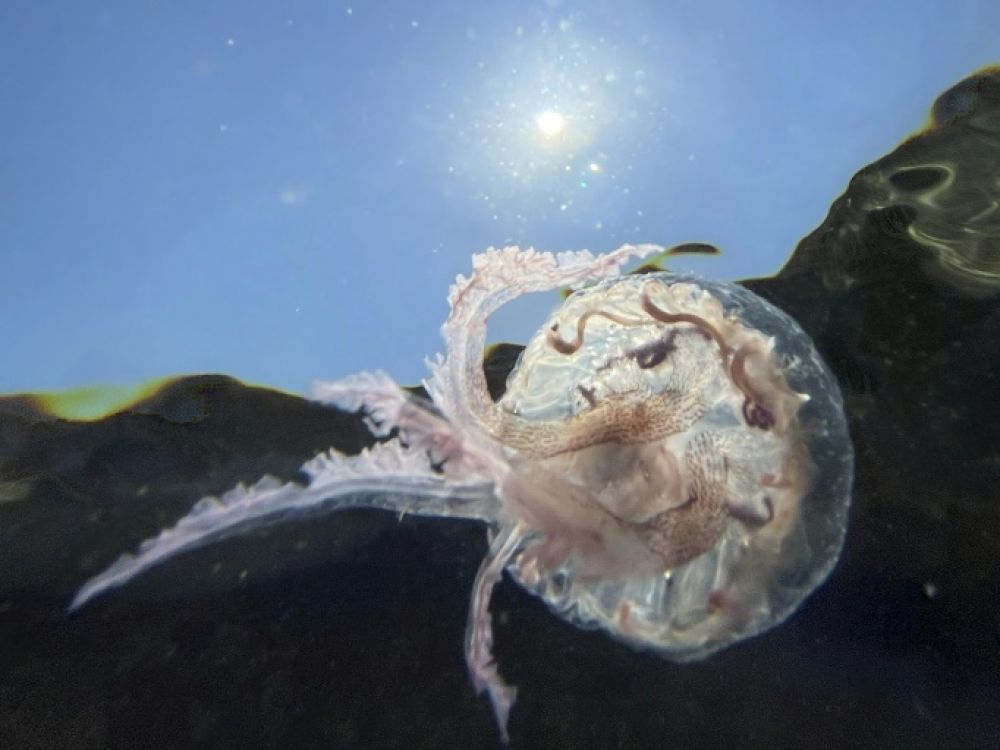They are small and purple, and their stings are incredibly painful: if jellyfish bother bathing on the Mediterranean coast, they also have specific physiological properties, the study of which includes advanced science and suggests multiple uses.
Since mid-June, on many beaches of Corsica and the Riviera, Pelagia noctiluca, the tiny purple jellyfish found everywhere in the Mediterranean, has been blown away by the dozens by the sea waves, but the hope of getting rid of them is just delusion.
Consisting of 95 to 98% water, brainless, able to float and swim but not resistant to ocean currents, it is part of the zooplankton. “They are present year-round, in a current that circles the Mediterranean and tends to stay offshore,” explained to AFP Fabien Lombard, professor and researcher at the Villefranche Sur Oceanographic Center. “It was the southern flow that brought them back to the coasts.”
In Ajaccio, thousands watched them. On Saint-François Beach, in the heart of the city, Simone Martini, an Italian bather, was one of many who made a agonizing confrontation: covered in stinging cells, ocular cells, jellyfish tentacles touching his forehead, spearing spears injecting a mixture of venom.
– Bite to eat –
“Fifteen days later, I still have burns that sometimes hurt,” he told AFP.
Fabian Lombard explains, “These blind animals bite everything they touch in an attempt to eat. They inject neurotoxins to discourage their prey, and they impart digestive enzymes.”
Websites make it possible to track their presence, such as meduseo.com or www.frequence-sud.fr/carte-meduses. Each person has their own way of relieving post-injection pain. “Peeing on it is useless,” laughs Fabian Lombard, and advises against “rubbing, rinsing with sea water and removing stinging cells with wet sand.”
On the ecological level, its spread would be such that it would cause the oceans to “crystallize”, according to a September 2019 report from the Intergovernmental Panel on Climate Change (IPCC).
An assertion that divides the scientific community: “We don’t have reliable measurements to say there is more,” defines Fabian Lombard. While we realize that “in the 80s and 90s, in Villefranche-sur-Mer, there were 5-6 years with the jellyfish and the next 5-6 years without it, it is the 25th non-stop year with the jellyfish”.
For Lovina Vollgrabe, a scientist at the Underwater Research and Oceanography Station (Stareso) in Calvi (Haute-Corse), “overfishing, which eliminates predators such as tuna or turtles, is one of the” favorite hypotheses to explain this larger recurrence.
And if in 2013 the United Nations Food Organization (FAO) recommended eating them, to combat its spread, Fabian Lombard warns against the idea of treating “symptoms of sea imbalance” rather than the original disease. Fish depletion due to overfishing.
– Two Nobel Prizes –
But if these animals are worrisome, they have also helped make significant scientific advances.
In 1913, the Nobel Prize for Medicine was awarded for work related to the function of the venom of jellyfish cousins that made it possible to understand “anaphylactic shock”: the venom decreases rather than strengthens the immunity of people who have already been stung.
“It was somewhat revolutionary, until then everyone was more into the idea that + the more you expose yourself to something, the less sensitive you are to it +,” explains Fabian Lombard.
In 2008, a second Nobel Prize, this time in chemistry, was awarded for work on the ability of some jellyfish to glow in the dark, via a protein. The Nobel Committee noted in 2008 that many biochemists, biologists, and medical researchers have used this fluorescence in their research, particularly in relation to tumors or Alzheimer’s disease.
Fabian Lombard “has revolutionized cell biology by making it possible to literally + turn on + cells when they are activated, to see how they work”, summed up Fabian Lombard.
NASA has set out to launch jellyfish on spaceflights to study their reproduction in weightlessness, and the European Union launched a call for projects in 2017, “GoJelly,” to study how to use them in the food, fertilizer, cosmetic, and decontamination sectors.
Because “jellyfish are full of potential,” the teacher-researcher asserts: They are used as aquaculture food, fertilizer, or soil moisture stabilizer for crops like vineyards in lands, rice in China or basil in Mexico. Collagen is used in cosmetics and diapers or tampons in Israel, and to soften concrete in anti-seismic installations in Russia, the scientist lists.
For him, the most promising use is “jellyfish mucus,” made up of a molecule that “appears to promote the growth of human cartilage.”
To meditate during your next swim.

“Subtly charming problem solver. Extreme tv enthusiast. Web scholar. Evil beer expert. Music nerd. Food junkie.”

